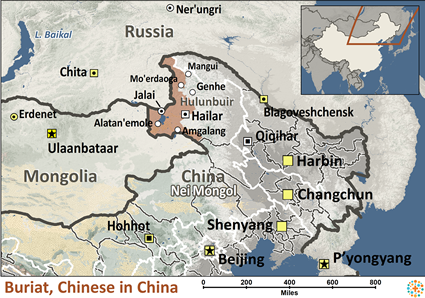The Buriat in China inhabit grasslands in the Hulunbuir region of the Inner Mongolia Autonomous Region. This remote area is located where the three nations of China, Russia and Mongolia meet. The Buriat originally consisted of several Mongolian people groups and clans who were recognized as five distinct tribes. The Buriat—who claim to be descended from either a grey bull or a white swan—still share many common traits and customs with the Mongols.
The 1982 China language census listed 65,000 speakers of the Buriat language in China. In later censuses the Chinese authorities did not count the Buriat separately but included them under the Mongolian nationality. Large numbers of Buriat people also live in Russia and Mongolia but, because of historical and political influences, the Buriat in each country now speak different languages and should be considered three different groups from an ethnolinguistic standpoint. The Buriat in China are relatively recent arrivals, having migrated from Siberia to Inner Mongolia in 1917.
The Buriat language spoken in China is different from the Buriat in Mongolia and Russia. They reportedly 'speak a highly distinctive dialect of Mongolian '. The two main dialects of Buriat in China are known as New Bargu and Old Bargu. Some sources suggest these two dialects are so different that they may represent distinct languages, but there needs to be more research.
The yokhor folk dance plays an important role in the lives of the Buriat. Girls imitate the actions and movements of birds and animals. Most Buriat live in mud and wood houses, although some are still nomads.
Most Buriat live in mud and wood houses, although some are still nomads.
Historically, most Buriat believed in shamanism, allowing mediums to control all interactions between the gods and their communities. To be a shaman, a person had to be seen to possess utkha, a mystical spiritual energy. In the 1500s, Buddhist missionaries from Tibet travelled into Mongolia and introduced Tibetan Buddhism. It soon grew in influence, and what grew out of it was a mixture of Buddhist teachings and shamanist practices. In the past century many Buriat in Russia and Mongolia became atheists under the communist system, but a significant number of Buriat in China have continued to believe in Buddhism. A new religion called Burkanism has also appeared among them in recent years.
A few of the Buriat in China have become Christians, resulting from Chinese house church efforts originating in a revival in Heilongjiang Province. There are more than 20,000 believers in the city of Daqing. They took responsibility for evangelizing westward into Inner Mongolia, boldly preaching the gospel. The new Buriat believers are hampered by a lack of Scriptures and other resources in their language.
The Buriat people need to submit to Jesus Christ so they can experience the abundant life he offers them in John 10:10.
Pray for the spiritual blindness and bondage to the evil one to be removed so they can understand and respond to Christ.
Pray for the Lord to provide for their physical and spiritual needs as a testimony of his power and love.
Pray that the Buriat people will have a spiritual hunger that will open their hearts to the King of kings.
Pray for an unstoppable movement to Christ among them.
Scripture Prayers for the Buriat, Chinese in China.
Peoples of the Buddhist World, Asia Harvest, Copyrighted © Used with permission
| Profile Source: Joshua Project |

























